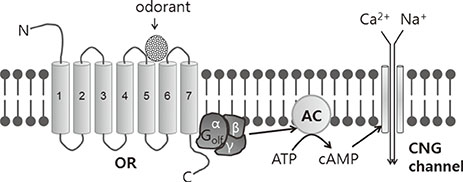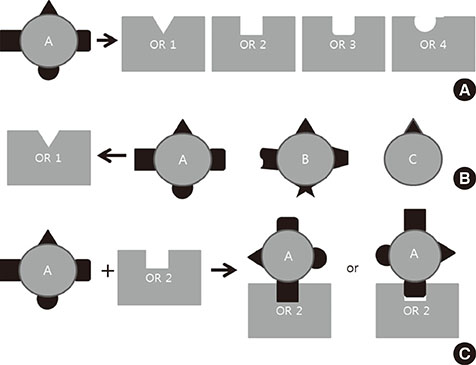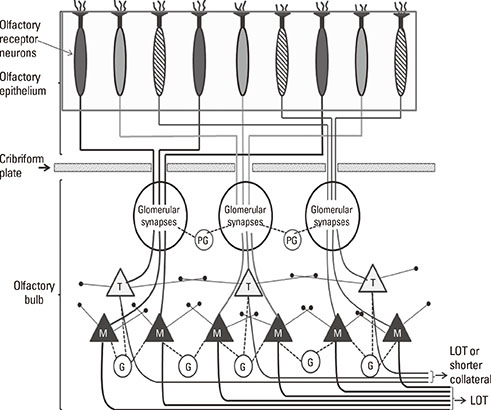Hanyang Med Rev.
2014 Aug;34(3):100-106. 10.7599/hmr.2014.34.3.100.
Understanding the Human Sensory Conduction of Smell
- Affiliations
-
- 1Department of Otorhinolaryngology-Head and Neck Surgery, Dongguk University Medical Center, Goyang, Korea. sw43857@dumc.or.kr
- KMID: 2284349
- DOI: http://doi.org/10.7599/hmr.2014.34.3.100
Abstract
- The olfactory epithelium is the main end organ for the sense of smell in humans and vertebrates. Specially differenciated neuronal cells called olfactory receptor neurons (ORNs) play a key role in the olfactory epithelium by expressing the olfactory receptors (ORs) on their apical surface membrane. The ORs are G-protein coupled receptors that transmit signals from odorants to ORNs by molecular cascades using cyclic adenosine monophosphate, calcium ions and other molecules, which result in the depolarization of ORN. Unlike other mammalian animals, only about 30% of OR genes in the human genome are expressed. The Nobel Prize was awarded to the scientists who cloned these ORs for the first time. Each ORN expresses only a single type of OR, and ORNs which express the same type of OR converge together into the same glomeruli in the olfactory bulb. A single OR recognizes multiple odorants, and a single odorant is recognized by multiple ORs with varying affinities. At the higher neurons beyond the bulb, neuronal connections are divergent. The combinatorial model of odor identification and discrimination is well established at the convergence level, but little is known about the action mechanisms of neuronal divergence for odor identification and discrimination and further study is required.
MeSH Terms
-
Adenosine Monophosphate
Animals
Awards and Prizes
Calcium
Clone Cells
Discrimination (Psychology)
Genome, Human
GTP-Binding Proteins
Humans
Ions
Membranes
Neurons
Nobel Prize
Odors
Olfactory Bulb
Olfactory Mucosa
Olfactory Pathways
Olfactory Receptor Neurons
Receptors, Odorant
Smell*
Vertebrates
Adenosine Monophosphate
Calcium
GTP-Binding Proteins
Ions
Receptors, Odorant
Figure
Cited by 1 articles
-
Unravel the Secret of Olfaction
Seok Hyun Cho
Hanyang Med Rev. 2014;34(3):97-99. doi: 10.7599/hmr.2014.34.3.97.
Reference
-
1. Buck L, Axel R. A novel multigene family may encode odorant receptors: a molecular basis for odor recognition. Cell. 1991; 65:175–187.
Article2. Lane AP, Gomez G, Dankulich T, Wang H, Bolger WE, Rawson NE. The superior turbinate as a source of functional human olfactory receptor neurons. Laryngoscope. 2002; 112:1183–1189.
Article3. Moran DT, Rowley JC 3rd, Jafek BW, Lovell MA. The fine structure of the olfactory mucosa in man. J Neurocytol. 1982; 11:721–746.
Article4. Crews L, Hunter D. Neurogenesis in the olfactory epithelium. Perspect Dev Neurobiol. 1994; 2:151–161.5. Schwob J. Neural regeneration and the peripheral olfactory system. Anat Rec. 2002; 269:33–49.
Article6. Caggiano M, Kauer JS, Hunter DD. Globose basal cells are neuronal progenitors in the olfactory epithelium: a lineage analysis using a replication-incompetent retrovirus. Neuron. 1994; 13:339–352.
Article7. Kwon HJ, Koo JH, Zufall F, Leinders-Zufall T, Margolis FL. Ca extrusion by NCX is compromised in olfactory sensory neurons of OMP mice. PLoS One. 2009; 4:e4260.8. Elsaesser R, Paysan J. The sense of smell, its signalling pathways, and the dichotomy of cilia and microvilli in olfactory sensory cells. BMC Neurosci. 2007; 8:Suppl 3. S1.
Article9. Ko HJ, Park TH. Enhancement of odorant detection sensitivity by the expression of odorant-binding protein. Biosens Bioelectron. 2008; 23:1017–1023.
Article10. Glusman G, Yanai I, Rubin I, Lancet D. The complete human olfactory subgenome. Genome Res. 2001; 11:685–702.
Article11. Gilad Y, Lancet D. Population differences in the human functional olfactory repertoire. Mol Biol Evol. 2003; 20:307–314.
Article12. Freitag J, Ludwig G, Andreini I, Rossler P, Breer H. Olfactory receptors in aquatic and terrestrial vertebrates. J Comp Physiol A. 1998; 183:635–650.
Article13. Mombaerts P. Odorant receptor genes in humans. Curr Opin Genet Dev. 1999; 9:315–320.
Article14. Chess A, Simon I, Cedar H, Axel R. Allelic inactivation regulates olfactory receptor gene expression. Cell. 1994; 78:823–834.
Article15. Rodriguez I, Greer CA, Mok MY, Mombaerts P. A putative pheromone receptor gene expressed in human olfactory mucosa. Nat Genet. 2000; 26:18–19.
Article16. Liberles SD, Buck LB. A second class of chemosensory receptors in the olfactory epithelium. Nature. 2006; 442:645–650.
Article17. Buck LB. Olfactory receptors and odor coding in mammals. Nutr Rev. 2004; 62:S184–S188. discussion S224-41.
Article18. Jones DT, Reed RR. Golf: an olfactory neuron specific-G protein involved in odorant signal transduction. Science. 1989; 244:790–795.
Article19. Brunet LJ, Gold GH, Ngai J. General anosmia caused by a targeted disruption of the mouse olfactory cyclic nucleotide-gated cation channel. Neuron. 1996; 17:681–693.
Article20. Lin W, Arellano J, Slotnick B, Restrepo D. Odors detected by mice deficient in cyclic nucleotide-gated channel subunit A2 stimulate the main olfactory system. J Neurosci. 2004; 24:3703–3710.
Article21. Spehr M, Wetzel CH, Hatt H, Ache BW. 3-phosphoinositides modulate cyclic nucleotide signaling in olfactory receptor neurons. Neuron. 2002; 33:731–739.
Article22. Gomez G, Rawson NE, Cowart B, Lowry LD, Pribitkin EA, Restrepo D. Modulation of odor-induced increases in [Ca(2+)](i) by inhibitors of protein kinases A and C in rat and human olfactory receptor neurons. Neuroscience. 2000; 98:181–189.
Article23. Kaur R, Zhu XO, Moorhouse AJ, Barry PH. IP3-gated channels and their occurrence relative to CNG channels in the soma and dendritic knob of rat olfactory receptor neurons. J Membr Biol. 2001; 181:91–105.
Article24. Morales B, Bacigalupo J. Chemical reception in vertebrate olfaction: evidence for multiple transduction pathways. Biol Res. 1996; 29:333–341.25. Wetzel CH, Spehr M, Hatt H. Phosphorylation of voltage-gated ion channels in rat olfactory receptor neurons. Eur J Neurosci. 2001; 14:1056–1064.
Article26. Reisert J, Bauer PJ, Yau KW, Frings S. The Ca-activated Cl channel and its control in rat olfactory receptor neurons. J Gen Physiol. 2003; 122:349–363.
Article27. Restrepo D. The ins and outs of intracellular chloride in olfactory receptor neurons. Neuron. 2005; 45:481–482.
Article28. Connelly PA, Sisk RB, Schulman H, Garrison JC. Evidence for the activation of the multifunctional Ca2+/calmodulin-dependent protein kinase in response to hormones that increase intracellular Ca2+. J Biol Chem. 1987; 262:10154–10163.
Article29. Boekhoff I, Breer H. Termination of second messenger signaling in olfaction. Proc Natl Acad Sci U S A. 1992; 89:471–474.
Article30. Noe J, Tareilus E, Boekhoff I, Breer H. Sodium/calcium exchanger in rat olfactory neurons. Neurochem Int. 1997; 30:523–531.
Article31. Takeuchi H, Kato H, Kurahashi T. 2,4,6-trichloroanisole is a potent suppressor of olfactory signal transduction. Proc Natl Acad Sci U S A. 2013; 110:16235–16240.
Article32. Zhao H, Ivic L, Otaki JM, Hashimoto M, Mikoshiba K, Firestein S. Functional expression of a mammalian odorant receptor. Science. 1998; 279:237–242.
Article33. Malnic B, Hirono J, Sato T, Buck LB. Combinatorial receptor codes for odors. Cell. 1999; 96:713–723.
Article34. Nef P, Hermans-Borgmeyer I, Artieres-Pin H, Beasley L, Dionne VE, Heinemann SF. Spatial pattern of receptor expression in the olfactory epithelium. Proc Natl Acad Sci U S A. 1992; 89:8948–8952.
Article35. Zhao H, Ivic L, Otaki JM, Hashimoto M, Mikoshiba K, Firestein S. Functional expression of a mammalian odorant receptor. Science. 1998; 279:237–242.
Article36. Brookes JC, Hartoutsiou F, Horsfield A, Stoneham A. Could humans recognize odor by phonon assisted tunneling? Phys Rev Lett. 2007; 98:038101.
Article37. Turin L. A spectroscopic mechanism for primary olfactory reception. Chem Senses. 1996; 21:773–791.
Article38. Hara J. Olfactory discrimination between glycine and deuterated glycine by fish. Experientia. 1977; 33:618–619.
Article39. Havens BR, Meloan CE. The application of deuterated sex pheromone mimics of the american cockroach (Periplaneta americana, L.), to the study of wright's vibrational theory of olfaction. In : George C, editor. Developments in Food Science. New York: Elsevier;1995. p. 497–524.40. Haffenden LJW, Yaylayan VA, Fortin J. Investigation of vibrational theory of olfaction with variously labelled benzaldehydes. Food Chem. 2001; 73:67–72.
Article41. Keller A, Vosshall L. A psychophysical test of the vibration theory of olfaction. Nat Neurosci. 2004; 7:337–338.
Article42. Gane S, Georganakis D, Maniati K, Vamvakias M, Ragoussis N, Skoulakis EMC, et al. Molecular vibration-sensing component in human olfaction. PLoS One. 2013; 8:e55780.
Article43. Kosaka K, Toida K, Aika Y, Kosaka T. How simple is the organization of the olfactory glomerulus?: the heterogeneity of so-called periglomerular cells. Neurosci Res. 1998; 30:101–110.
Article44. Hamilton KA, Heinbockel T, Ennis M, Szabo G, Erdelyi F, Hayar A. Properties of external plexiform layer interneurons in mouse olfactory bulb slices. Neuroscience. 2005; 133:819–829.
Article45. Price J. Olfactory system. In : Paxinos G, editor. The human nervous systemed. San Diego: Academic Press;1990. p. 979–998.46. Haberly LB. Olfactory cortex. In : Shepherd GM, editor. The synaptic organization of the brain. 4th ed. New York: Oxford University Press;1998. p. 377–416.47. Royet JP, Plailly J. Lateralization of olfactory processes. Chem Senses. 2004; 29:731–745.
Article48. Imai T, Sakano H, Vosshall LB. Topographic mapping--the olfactory system. Cold Spring Harb Perspect Biol. 2010; 2:a001776.
Article49. Giessel AJ, Datta SR. Olfactory maps, circuits and computations. Curr Opin Neurobiol. 2014; 24:120–132.
Article50. Jia H, Pustovyy OM, Waggoner P, Beyers RJ, Schumacher J, Wildey C, et al. Functional MRI of the olfactory system in conscious dogs. PLoS One. 2014; 9:e86362.
Article51. Park SK, Kim JH, Yang ES, Ahn DK, Moon C, Bae YC. Ultrastructure and synaptic connectivity of main and accessory olfactory bulb efferent projections terminating in the rat anterior piriform cortex and medial amygdala. Brain Struct Funct. Forthcoming 2013.
Article
- Full Text Links
- Actions
-
Cited
- CITED
-
- Close
- Share
- Similar articles
-
- Role and Cultural History of Human Olfaction and Smell
- Pitfalls in Superficial Radial Sensory Nerve Conduction Study
- Functional Activity of the Central Olfactory Pathways
- Measurement of Median Sensory Nerve Conduction Velocity in Koreans, Using Somatosensory Evoked Potential
- The Diagnostic Value of Segmental Nerve Conduction Study in Diabetics




